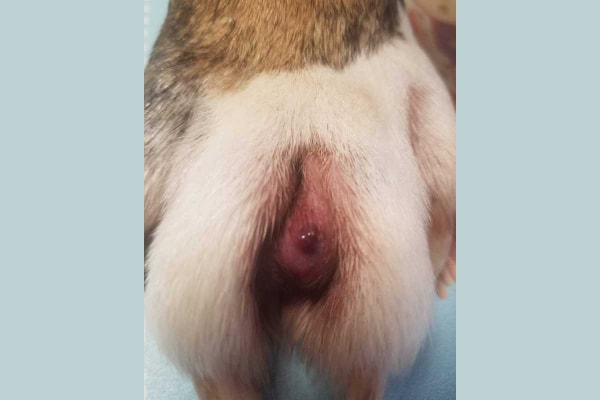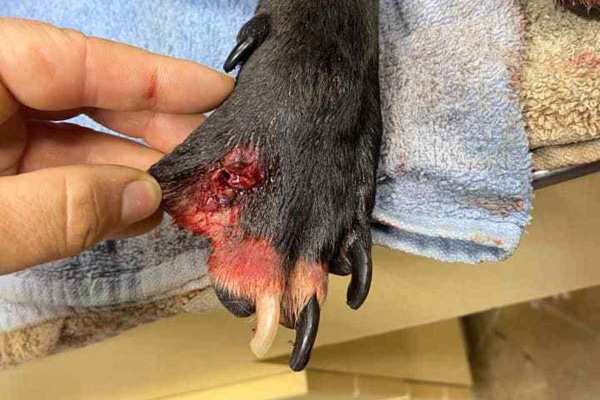Laser Therapy
A CO2 laser will vaporize the affected tissue and allow healing which won’t alter your dog’s normal paw structure. But it can take multiple treatments.
If your dog gets repeated occurrences of these cysts, it could be a deeper issue or an allergic reaction or sensitivity. Especially if the cysts appear along with other symptoms like weepy eyes and rashes or gastrointestinal issues. Then you need to look deeper into the diet or environmental influences.
What does an interdigital cyst look like?
Interdigital cysts, as the name would imply, appear between the digits (i.e. toes). They usually form in the webbing between a dog’s toes on the top side of the paw. However, in rare cases they can appear on the bottom of the paw instead.
Initially, interdigital cysts start in the deeper skin layers. Then they rise to the surface where you can see them. At this point, the cysts are raised, painful, purple or red nodules, as shown in the photo below of an interdigital cyst in dogs. The hair is often missing from the area, resulting in the cyst having a shiny, prominent appearance.
Additionally, interdigital cysts might contain a bloody, pus-like material. Sometimes a dog’s interdigital cyst can burst or “pop,” and start draining this material or bleeding out of a small hole in the center of the cyst.
Dogs can have one cyst or multiple cysts, depending on what caused them and how long it has been going on.

On a basic level, interdigital cysts are almost always caused by a bacterial infection that has affected the deeper layers of skin (i.e. deep pyoderma in dogs). But most of the time there are additional factors in play as well.
The most common factor is breed predisposition. Some of the frequently affected breeds are Chinese Shar Peis, English Bulldogs, and Labrador Retrievers. These breeds tend to develop cysts because of:
Short hair is especially a problem for these dogs because it acts as an irritant to the paw. Not only can it cause itching and inflammation, but it can also be shoved back into the hair follicles as your dog walks and the toes rub together. The result is ingrown hairs that are irritating to your dog and can predispose him or her to secondary bacterial skin infections.
When other breeds of dogs are affected by interdigital cysts, they are usually suffering from another skin disease that has lead to the infection. There are four conditions that are most often associated with developing an interdigital cyst:
As gross as this sounds, all dogs have demodex mites that live in their hair follicles. Normally these mites don’t cause any issues. However, some dogs, especially those with poor immune systems, can develop a mite overpopulation. The end result is a deep skin infection on various parts of the body, including the feet in some cases.
Another common cause of interdigital cysts in dogs is secondary infection from canine atopic dermatitis (i.e. environmental allergies). Dogs may be allergic to things that are in the environment seasonally such as weeds, grasses, trees, etc. Or they can be allergic to dust mites, storage mites, or other environmental components that are around all year.
Allergies lead to itching, which can lead to skin trauma, deep infections, and interdigital cysts. Since that is the case, stopping the itch is important. While Benadryl for dogs might be enough to help some dogs, others need stronger allergy medicine for dogs like Cytopoint® or Apoquel®.
Foxtails in dogs and other grass seeds can act as foreign bodies that lodge in your dog’s paws. If the grass awn isn’t removed, it will continue to bury deeper into the paw. This will lead to irritation and infection that spreads to the nearby hair follicles.

Dogs who are overweight put more pressure on their paws and toes when walking. This causes increased friction and irritation between the toes. The resulting skin damage plus the potential for the hairs to be pushed into the skin can make an overweight dog more prone to ingrown hairs and interdigital cysts.
How to treat interdigital cysts at home
It’s hard to see your furry friend limping or licking. It’s a painful experience for your dog and painful for you to watch. Thankfully, there are at-home treatment options for interdigital cysts. Your vet may recommend reducing your dog’s weight, regularly cleaning paws, and applying a paw balm. In general, bathing, topical treatments, and overall good hygiene are key parts of initially treating interdigital cysts, particularly for treating chronic lesions.
Make a habit of checking your dog’s paws daily — Dogs trek around on rough surfaces during hot and cold weather, and that can wear out your pet’s paws.
Paw balms, shampoos, and soaks can soothe and alleviate your pup’s pain — Cleansing paws with a shampoo and Epsom salt soak is a good first step. Then keep paws steppin’ comfortably with paw balms that lock in moisture.
If you have an appointment with your veterinarian or veterinary dermatologist, avoid using topicals and soaks — This way, the veterinary dermatologist can see what the dog’s toes look like without treatment.
Since most dogs won’t wear booties, protect their precious paws in other ways — Paw balms infuse your four-footed friend’s paws with all the protection they need. They help heal your dogs’ dry and cracked skin and also have anti-inflammatory properties.